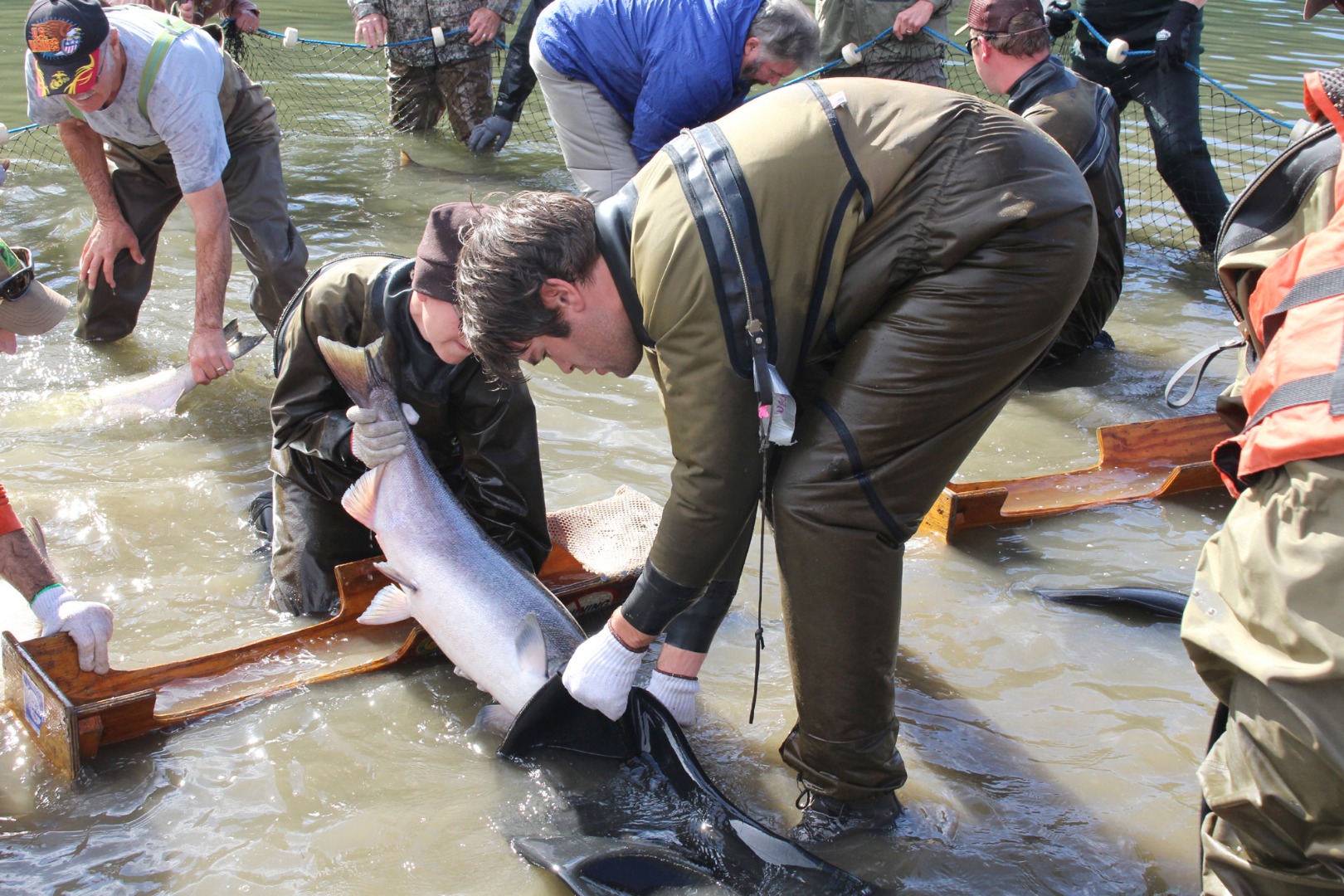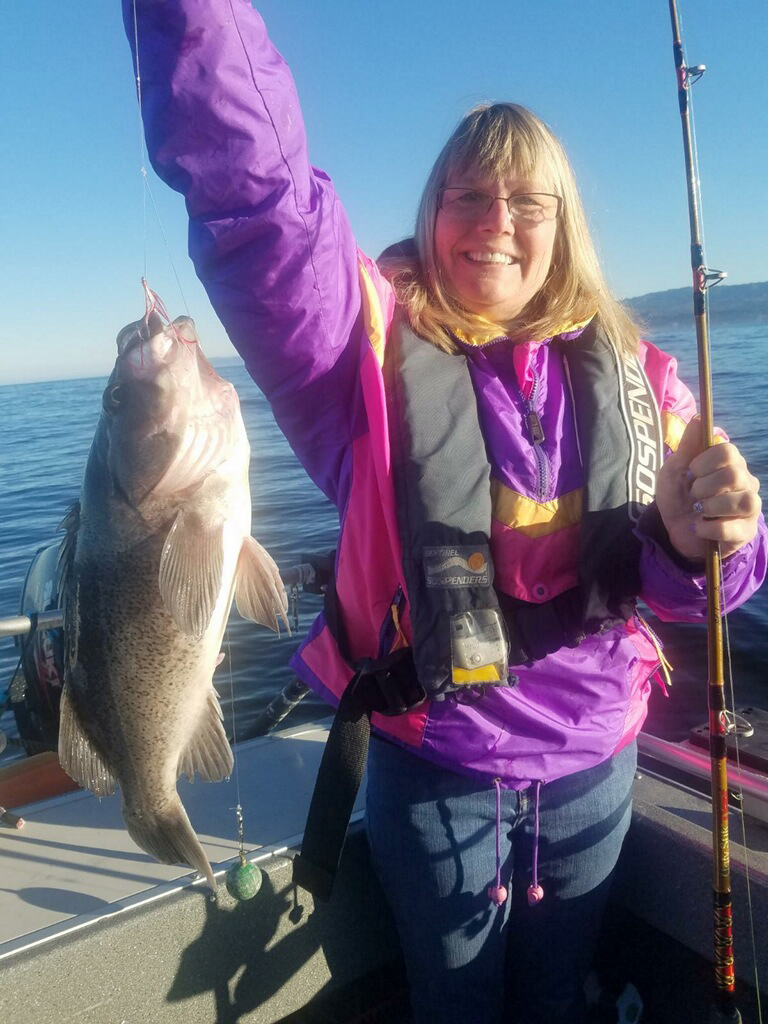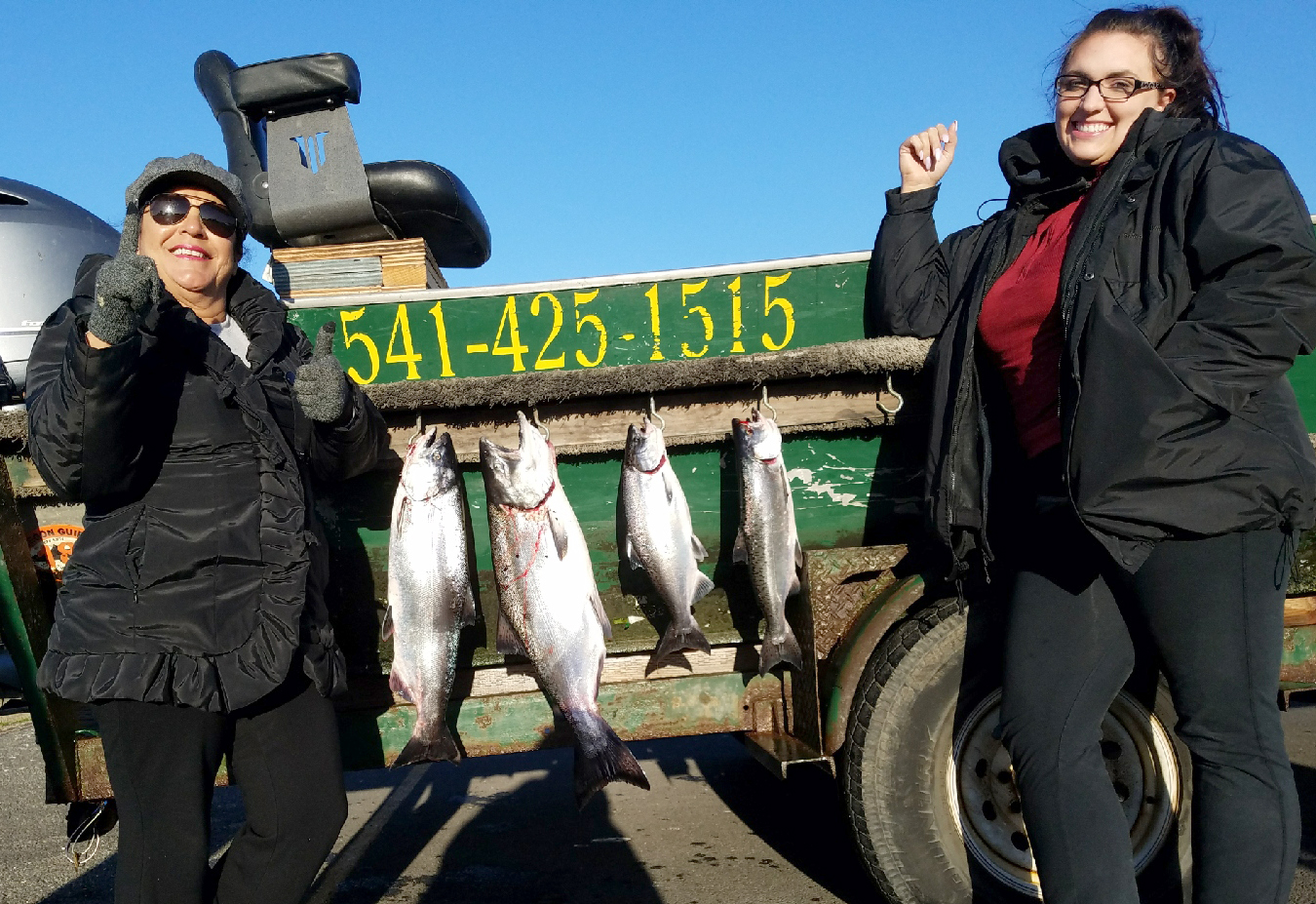From Sportfishing
Fish Report for 10-27-2018

100 Participants and Observers Seine the Chetco River for Broodstock Salmon
10-27-2018
Larry Ellis
For the second time this month, the Chetco River was seined at Social Security Bar for large Chinook in what has been classically called, “The Chetco River Broodstock Salmon Program.” This broodstock program only picks the best-looking and oldest, heaviest Chinook to be hauled away in hatchery trucks to be spawned at Elk River Hatchery in Bandon.
In fact, the Hatchery and Genetic Management Plan (HGMP) for Fall Chinook on the Chetco River clearly states, “Females collected should be at least 800 mm fork length, to insure that no age-3 females are utilized as broodstock.” So ODFW only takes age 4- and 5-year old females, and only the biggest males to insure that only the largest fish will return to the Chetco River.
The object of collecting large fish is to insure that a predominant return of Chinook will be large fish as well. It’s kind of like a “big fish begets big fish” type of theory. Although it can’t really be proven scientifically, the Chetco has always kicked out big fish. That’s enough science for this guy to assume that the big-fish theory holds water.
Over 60 spectators gathered on the North Bank of the Chetco River at Social Security Bar to watch 40 members from the Oregon South Coast Fishermen and ODFW haul in approximately 38 of the finest-caliber Chinook.
It was estimated that approximately 50 salmon were seined on the first pass alone. Approximately 20 salmon that were either too small for Chetco River standards or jack Chinook were thrown back over the nets, including one very large searun cutthroat trout and a fin-clipped summer steelhead. Every year, I usually see at least one coho get tossed back in the water; but not on Thursday’s seining.
No 50-pound kings were seen in this year’s seining project – so far. However, there were plenty of Chinook in the 30- and 40-plus-pound category seen in the net at SSB, just like the big fish that were caught in the estuary. By the amount of upper 30- and 40-pound Chinook I did see, I would estimate that next year will be the year to beat all years, when several 50 pounders will be caught, either in the bubble fishery or in the estuary.
On the second pass of Thursday last, OSCF and ODFW seined over 12 Chinook, but only kept approximately 6 specimens.
By the third pass, it was quite evident that the salmon had wizened up and were holed up tight in the deeper root wads and wooden snags at the upper end of Social Security Bar. So three of ODFW’s finest field biologists jumped in the water with their wet suits to try and spook these fish into the shallower, more-open part of SSB.
All I can say is there is nothing smarter than a skittish Chinook. OSCF and ODFW were able to get several salmon in the net on that third pass, but only one desirable specimen was taken to the hatchery truck.
For the second year in a row, ODFW has now upped their salmon smolt goal to 200,000 Chinook smolts instead of the former 150,000 smolt release program that it had in the last decade or so. Elk River Hatchery met the 200,000 smolt production for the Chetco River last year, and it looks like they are going to meet the same production this coming year as well.
It should be noted that the Chetco used to have a 350,000 Chinook smolt-release program, which was then reduced to a 200,000 Chinook smolt-release program in 1997.
And while we’re on the subject of smolt releases, 393,953 Chinook smolts were released in the year 1991, and 389,509 Chinook smolts were released into the Chetco the following year.
That’s close to a 400,000 smolt release for both 1991 and 1992, and that figure boggles my mind. So, I don’t see that the 200,000 smolt release is a big deal at all. That doesn’t surprise me one bit when you think that before the year 2007, the broodstock collection called for 150 pairs of fish, or 300 total Chinook. If you want to read it for yourself, it’s all spelled out in the HGMP.
So has the reduced smolt release and the reduced broodstock collection actually helped or hurt the Chetco? It is my opinion that the program should call for a raise in both smolt releases and broodstock collection.
But, in recent years, ODFW’s goal was to collect only 60 pair of Chinook, or 120 fish total. But this year, the program will be upped a little bit more.
“Our goal this year is to collect 75 pair of Chinook,” says district biologist Steve Mazur.
That’s 75 females and 75 males, for a whopping total of 150 collected broodstock Chinook.
Okay, so will 75 females make the production goal of 200,000 smolts? Here’s how to do the math on that one.
Oh, The Fecundity Of It All!
There happens to be a well-known scientific word called fecundity, which basically measures the amount of eggs that a female produces. In most reliable publications that I read, the fecundity of a female Chinook can range anywhere from 2,000 to 7,000 eggs, depending on the size and age of a fish. So, to be on the conservative side, let’s just assume that Chetco River female Chinook are going to average about 3,000 eggs each.
Taking ODFW’s present collection goal of 75 pairs of Chinook (75 females and 75 males), the egg take would then be exactly 225,000 eggs, enough eggs to meet this year’s production goal of 200,000 eggs, including a buffer of 25,000 eggs which will probably be lost to some sort of disease.
But here’s the rub.
Last year’s production goal was also 200,000 eggs, and that production figure was met as well by only collecting 60-females. If you do the math on that one, a female Chinook would have had to produce 3,333 eggs each to meet that 200,000 goal. So, to take into consideration the disease buffer, a fecundity rate averaging 3,700 eggs per female is not unreasonable in order to produce a 220,000 egg take.
Now, if you take into consideration that 3,700 fecundity rate and multiply it by 75 females, which is this year’s goal for collecting broodstock, the females would produce 277,500 eggs collectively. That 3,700-fecundity figure now sounds more reasonable to me, especially taking into consideration disease-related issues.
3,700 eggs per female – that’s my story and I’m stickin’ to it!
As usual, I’ve digressed once again.
So getting back to business, last Tuesday was the first Chetco River Broodstock seining of the year, when approximately 60 Chinook were seined at Social Security Bar, and then trucked to Elk River Hatchery.
If you add that 60-Chinook figure to the salmon that were collected on Thursday, ODFW could meet their collection production goal with about 60 more fish.
Bobber Rule On The Chetco To Be Extended Until Further Notice
It is now approaching the end of October and the beginning of November. November 4 is the day when all forms of angling open up on the Chetco – but not this week.
Due to the lack of rain, Steve Mazur asked me to inform the public that the bobber rule will be extended throughout the rest of the year from river mile 2.2 up to Nook Creek, or until sufficient rain occurs that would allow more salmon to escape upriver.
“If we get enough rain, we can open the season back up to all forms of angling within 2 days,” says Mazur.
So check the ODFW website at www.dfw.state.or.us and look for this rule change, which will be posted in the ODFW news releases.
But that should not prevent a person from tying into a strapping Chinook in the upper tidewater holes of Tide Rock, Morris Hole and SSB. Fishing with bobbers-and-eggs, bobbers-and-sand shrimp, or bobbers-and-sand shrimp cocktails has been reasonably good, especially in the early morning hours from one hour before sunrise until two hours after sunrise.
This is the time when salmon have settled in for the night and have more or less forgotten about being hammered by fishermen’s lures the previous day.
Also, remember that in these deep tidewater holes, salmon still have a taste for salt, especially baitfish like anchovies. I remember when using a half an anchovy, rigged tail first worked quite well for these fish.
When the sun hits the water, the bobbering game is usually over and done with.
Meanwhile, salty dogs who favor the Sebastes variety of rockfish and lingcod out of the Port of Brookings Harbor, have been averaging limits of rockfish and lingcod as well.
It should also be pointed out that fishing for surfperch has still been reasonably good, especially for anglers who wait for the calmer days to fish from the beach.
Jim Carey from the Rogue Outdoor Store has been saying how remarkably good the red-fin fishermen have been doing at local reefs such as Kissing Rock, the crook at the South Jetty and at the Nesika Beach Wayside.
Fishing for salmon in the Rogue bay has slowed down somewhat from last week, however, a few anglers have managed to tie into a Rogue bay Chinook by trolling the traditional spinnerbait rig. It’s all a matter of loving to fish and putting in your time.
Mazur says that the Indian Creek Fish have yet to show up at the hatchery, mainly due to lack of rain. But if a gully washer happens to hit the area, get ready for some fantastic fishing for Indian Creek (adipose fin-clipped) Chinook by casting Mepps Flying-Cs, 1-ounce chrome Krocodiles and 3/4-ounce blue-and-chrome Kastmasters from the south bank below Indian Creek.
The salmon fishing in the Rogue bay may have slowed down, but it’s not over by a longshot.
Tight lines!
Larry Ellis, author, writer, columnist and photographer has had a 50-year passion for fishing in California and Oregon's saltwater and freshwater venues. He is a well-known writer for Oregon, Washington and California Fishing and Hunting News, Northwest Sportsman, California Sportsman and Pacific Coast Sportfishing. He currently writes monthly for Salmon Trout Steelheader Magazine, and is the author of two books, "Plug Fishing for Salmon" and "Buoy 10, the World's Largest Salmon Run." Both books can be bought from Amato Publications (amatobooks.com), Amazon and eBay. Ellis particularly loves living in his hometown of Brookings, Oregon - The heart of salmon country and gateway to fishing paradise.
< Previous Report Next Report >
More Reports

10-20-2018
The wind and swells outside the Port of Brookings Harbor subsided enough for anglers to try their luck at catching...... Read More

10-12-2018
The very popular Chetco Bubble Fishery which takes place in state waters started out with two spectacular days on Saturday...... Read More

Website Hosting and Design provided by TECK.net